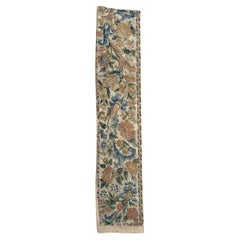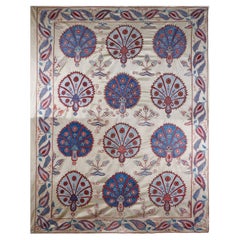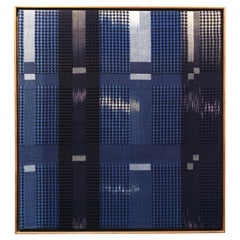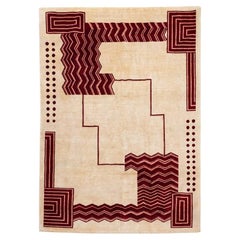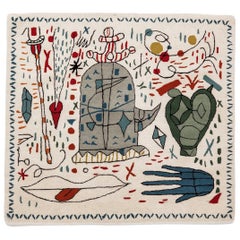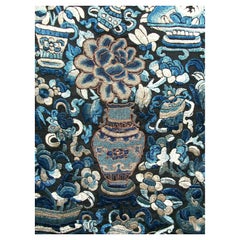Fabric Tapestries
to
462
2,129
1,947
3,138
971
138
Height
to
Width
to
519
289
100
88
84
59
58
30
29
21
16
16
14
12
11
8
4
3
747
720
1,671
1,109
290
870
394
46
5
47
37
38
99
135
159
51
20
4,247
2,852
989
922
215
2,058
1,362
1,220
530
417
4,247
3,585
3,816
128
96
59
30
24
Material: Fabric
Bobyrug’s pretty 18th century French needlepoint fragment
Located in Saint Ouen, FR
"Exquisite 18th-century French needlepoint tapestry fragment ! This beautiful and historic piece features a floral and foliage design in vibrant blue, green, orange, pink, and yellow...
Category
18th Century French Aubusson Antique Fabric Tapestries
Materials
Silk
Ottoman Silk Carnation Garden Hand Embroidered Suzani Tapestry
Located in London, GB
Discover the epitome of luxury with our Ottoman Carnation Motif Hand Embroidered Silk Suzani Tapestry. This exquisite piece features intricate carnation motifs, meticulously hand-emb...
Category
2010s Turkish Suzani Fabric Tapestries
Materials
Silk
$3,116 Sale Price
35% Off
Handwoven Ikat Natural Indigo & Plant Dyed Block Framed Artwork
By Pamela Print
Located in Chelmsford, GB
This striking contemporary piece of Handwoven textile art is one of a collection of one-off plant-dyed pieces designed and produced by British Weaver Pamela Print
This piece is dyed...
Category
2010s British Fabric Tapestries
Materials
Wool
Carpet, or tapestry, in wool, in Art Deco style. Contemporary work.
Located in Saint-Ouen, FR
NAME OF THE WORK:
LIMITED EDITION TO:
COPY: N°
BASED ON A WORK BY:
DIMENSIONS (APPROX.): H 296 cm x W 215 cm
SURFACE: 6.36 M2
WEAVING DATE: 2023
DENSITY: knots
This rug, or tapestr...
Category
21st Century and Contemporary Fabric Tapestries
Materials
Wool
Jaime Hayon & Nani Marquina 'Nani x Hayon' Wall Tapestry
Located in Tilburg, NL
Jaime Hayon & Nani Marquina 'Nani x Hayon' wall tapestry
Hayon x Nani, size 120x130, comes with wall hanging solution made with fabric sleeves sewn to the top back of the rug.
...
Category
21st Century and Contemporary European Mid-Century Modern Fabric Tapestries
Materials
Wool
Fine Quality Embroidery on Silk - Qing Dynasty, China, Mid 19th Century
Located in Chatham, ON
Antique fine quality - Qing Dynasty - forbidden or seed stitch silk embroidery panel - metallic and silk threads - densely packed embroidery on a light weight damask pattern silk - m...
Category
Mid-19th Century Chinese Chinese Export Antique Fabric Tapestries
Materials
Silk
$2,100 Sale Price
30% Off
Nice vintage French Aubusson Style Jacquard Tapestry cushion face
Located in Saint Ouen, FR
"Pretty small French tapestry from the late-20th century, featuring a beautiful design and nice colours, woven in jacquard loom by wool acrylic a...
Category
Late 20th Century French Aubusson Fabric Tapestries
Materials
Wool, Cotton, Acrylic
Large 17th Century Aubusson Tapestry
Located in LYON, FR
Stunningly vivid late 17th early 18th century Aubusson tapestry. Strong Verdure themes with a scene depicting Bathsheba and David in the centre. An unusually large amount of silk was...
Category
Late 17th Century French Aubusson Antique Fabric Tapestries
Materials
Wool, Silk
$11,800 / set
17th Century Tapestry/Gobelein Alexander The Great And Darius III Persian King
Located in Berlin, DE
Monumental Museum tapestry/Gobelein 17th century Battle scene Alexander the Great and Darius III Persian King
The characters are depicted in life size. An absolute museum unique.
Dimension: 530x320 cm
Description:
Monumental tapestry...
Category
17th Century French Antique Fabric Tapestries
Materials
Wool, Silk
Vintage Tapestry Depicting a Hidden Forest 5'5" X3'6"
Located in Los Angeles, US
A wall hanging tapestry, simply put, is a textile specifically designed and woven to portray an artistic scene with the intent of hanging it on a wall. Antique tapestries, those that...
Category
Early 2000s Unknown Other Fabric Tapestries
Materials
Wool, Cotton
Helen Webber Signed Monumental Large Custom Framed Jungle Scene Woven Tapestry
Located in Studio City, CA
A truly stunning, one-of-a-kind work by California master tapestry artist Helen Webber featuring various wild natural creatures in an African jungle scene. The colors are so rich and vibrant. This, without question, is one of the most wonderful pieces we have come across in some time.
A vibrant, rich, heavy, substantial work overall. Displayed in a custom crackle finish frame. Sure to stand out in about any setting. This work leaps off the wall. Truly a designer's dream.
The tapestry is signed by Webber in the lower left.
Webber's works can be seen in a number of various settings including worship centers/churches/temples, hospitals and health care facilities (Betty Ford...
Category
1980s American Modern Vintage Fabric Tapestries
Materials
Fabric, Wool
Bit Map Throw Blanket 03, 100% Cotton Woven Contemporary Pixel Art, 60"x80"
By Luft Tanaka
Located in Brooklyn, NY
Bit map throw blanket 03 by Luft Tanaka Studio
A multicolored graphic throw blanket / wall tapestry woven out of 100 % cotton yarn based on digital pixel art created using an early bitmap drawing software from the 1980s and 1990s.
Measures: 60" x 80" / 152cm x 203cm
The Bit Map Series is based on digital “doodles” Luft makes using Kid Pix, a bitmap drawing software created by Craig Hickman in the 80s & 90s. Throughout the 90s, Kid Pix became a computer lab sensation in primary schools around the globe. Luft too, vividly remembers his first experiences with the the software in his kindergarten classroom, and enjoys creating with the software to this day.
Graphic art generated with the vintage software are edited, converted and digitally woven to make a soft and cozy blanket...
Category
21st Century and Contemporary American Modern Fabric Tapestries
Materials
Cotton
Late 17th Century French Aubusson Tapestry
Located in New York, NY
A French Aubusson Biblical tapestry from the late 17th century, depicting King Solomon and the Queen of Sheba seated on a throne at center, flanked on either side by attendants, to t...
Category
Late 17th Century French Aubusson Antique Fabric Tapestries
Materials
Wool
Abstract Tapestry by John Smith
By John Smith
Located in Winnetka, IL
Multi color mid century abstract tapestry by John Smith.
Category
1960s American Vintage Fabric Tapestries
Materials
Wool
Medieval Petit Point Tapestry Around 1980 - 1m37hx1m00l - N° 1146
Located in Paris, FR
A stone's throw from the Eiffel Tower We are a family business specializing in the purchase, sale and
expertise of old, modern and contemporary tapestries, rugs, kilims and textiles....
Category
1980s French Aubusson Vintage Fabric Tapestries
Materials
Wool, Silk
Antique 19th Century Suzani Panel Wall Hanging
Located in Delray Beach, FL
Antique Uzbek wall hanging made of combination of hand embroidery Suzani squares, silk Ikat, antique velvet and other textile all together with decorativ...
Category
Early 1900s Uzbek Antique Fabric Tapestries
Materials
Cotton, Wool, Velvet, Silk
$900 Sale Price
43% Off
17th Century Antique French Beauvais Grotesque Tapestry
Located in New York, NY
17th century French grotesque tapestry
An antique French Beauvais tapestry from the 17th century, depicting a Grotesque scene with an Elephant and ...
Category
17th Century French Antique Fabric Tapestries
Materials
Wool
$240,000 Sale Price
20% Off
Michèle RAY - Modern French Aubusson Tapestry 20th Signed, Monogram, No. 1443
Located in Paris, FR
A stone's throw from the Eiffel Tower We are a family business specializing in the purchase, sale and
expertise of old, modern and contemporary tapestries, rugs, kilims and textiles....
Category
Late 20th Century French Aubusson Fabric Tapestries
Materials
Wool
21x37 in 100% Silk Wall Hanging. Hand Embroidered Tablecloth. Modern Wall Decor
Located in Spring Valley, NY
Celebrate the rich heritage of Asian craftsmanship with this exquisite 100% silk Suzani textile, meticulously hand-embroidered by skilled artisans. A true work of art, this piece emb...
Category
2010s Central Asian Suzani Fabric Tapestries
Materials
Silk
32" x 39" Knotted Fiber Art Sculpture, Macrame Wall Hanging, KNITKNOT – nubes
Located in WARMENHUIZEN, NL
This macrame / knitted tapestry is MADE TO ORDER. The time needed to create this design is 11-12 weeks.
Because this fiber art tapestry is made to order, please allow some slight v...
Category
2010s Dutch Modern Fabric Tapestries
Materials
Wool, Alpaca, Yarn, Foam
Vintage Art Deco French Tapestry. Size: 5 ft 9 in x 6 ft
Located in New York, NY
Beautiful textile art square size vintage Art Deco French tapestry, country of origin / Type: French, circa date 1930's. Size: 5 ft 9 in x 6 f...
Category
Early 20th Century French Art Deco Fabric Tapestries
Materials
Wool
Antique Verdure Aubusson Tapestry with Birds
Located in New York, NY
French, 18th century Verdure Aubusson tapestry handwoven in wool with silk highlights framed with a complete floral border. Two birds wade ...
Category
18th Century French Aubusson Antique Fabric Tapestries
Materials
Wool, Silk, Tapestry
Art Nouveau Embroidery, early 20th C. France
Located in Istanbul, TR
A rare item to comedy, has some over all ware., some structural damages. No lining.
Category
Early 20th Century French Art Nouveau Fabric Tapestries
Materials
Metallic Thread
“Heliotrope” Tapestry Signed by Hervé Lelong
By Hervé Lelong
Located in Beirut, LB
Tapestry in “pure laine vierge” signed by Hervé Lelong
Entitled “Heliotrope”
Depicting a colorful flowers scene in the style of J.Lurcat
Hand woven wool
Category
1960s French Mid-Century Modern Vintage Fabric Tapestries
Materials
Wool
Orange Fish, Elie Grekoff - French Tapestry By Atelier Pintons Frers - No. 1469
By Elie Grekoff, Pinton Freres
Located in Paris, FR
Artist: Elie Grekoff
Period: 20th century
Style: Design 50's and 60's
Condition: Perfect condition
Material: Wool
Width: 242 cm
Height: 148 cm
Depth: 0.5 cm
Marine theme: The centra...
Category
20th Century French Aubusson Fabric Tapestries
Materials
Wool
Antique French Tapestry Handwoven French Tapestry Verdure Scenic Tapestry
Located in New York, NY
Rare Antique French Tapestry Pictorial Woodsman Verdure 1920 Tapestry Large Tapestry Wall Hanging 5'2" x 6'8" 5 x 7 153cm x 204cm
circa 1920
"Thi...
Category
1920s French Vintage Fabric Tapestries
Materials
Wool
Beautiful 1960's Wall Tapestry - Rural Landscape
Located in Bern, CH
Beautiful 1960's Wall Tapestry with rural landscape design. Nice example of a Mid Century wall decoration / rug. Yellow, ochre, rust, brown & green colourways.
Measurements: Height: ...
Category
Mid-20th Century Swiss Mid-Century Modern Fabric Tapestries
Materials
Wool, Fabric
Antique 17th Century Flemish Tapestry 7'11" X 7'9"
Located in Los Angeles, US
A wall hanging tapestry, simply put, is a textile specifically designed and woven to portray an artistic scene with the intent of hanging it on a wall. Antique tapestries, those that...
Category
17th Century Unknown Other Antique Fabric Tapestries
Materials
Wool, Cotton
Bobyrug’s Pretty antique French Aubusson Tapestry
Located in Saint Ouen, FR
Very pretty mid century french Aubusson tapestry with beautiful design of a flowerpot with nice colours in a black background.
Entirely handwoven with wool and silk on cotton foundat...
Category
Mid-20th Century French Aubusson Fabric Tapestries
Materials
Wool, Silk
Early 19th Century English Framed Needlework
Located in Chapel Hill, NC
Early 19th century English framed sampler, unsigned. Simple with a Georgian brick manor house, crowns, etc. below an alphabet & numbers. Frame scuffs.
...
Category
Early 19th Century English Georgian Antique Fabric Tapestries
Materials
Fabric
Bobyrug’s pretty vintage Aubusson style french jacquard tapestry
Located in Saint Ouen, FR
Pretty vintage French Aubusson style tapestry with a nice design and light colours, woven in mechanical jacquard looms with cotton, wool and acrylic,
✨✨✨
"Experience the epitome of...
Category
Mid-20th Century French Aubusson Fabric Tapestries
Materials
Wool, Cotton, Acrylic
Large Medieval Style Tree of Life Floral Aubusson Tapestry Wall Hanging
Located in Nottingham, GB
Large Medieval Style Tree of Life Floral Aubusson Tapestry Wall Hanging
From a private collection
Free international shipping.
Category
20th Century Fabric Tapestries
Materials
Cotton
19th Century Uzbek Silk Embroidered Suzani Tapestry
Located in New York, NY
19th century Uzbekistani hand spun linen Suzani with silk embroidered floral motif and silk ikat border. Reverse side has original antique Fine hand printed cotton backing.
Category
19th Century Uzbek Suzani Antique Fabric Tapestries
Materials
Linen, Silk
$5,250 Sale Price
30% Off
Antique French Forest Scene Tapestry, circa 1880 4'6 x 10'
Located in New York, NY
Antique French Forest scene tapestry, circa 1880, 4'6 x 10'. An antique French fine hand-loomed tapestry, circa 1880. A forest scene, with trees and foliage surrounded by a floral bo...
Category
19th Century French Antique Fabric Tapestries
Materials
Wool
Enzo Mari Wall Hanging Quilted Tapestry Arazzo Canova Adone e Venere, Italy
Located in Vienna, AT
Enzo Mari Wall Hanging Quilted Tapestry Arazzo Canova Adone e Venere, 1999, Italy- Dimensions 102" x 59" x 1"
This large wall hanging designed by Mari was produced in 1999 and is no...
Category
1990s Italian Post-Modern Fabric Tapestries
Materials
Cotton
Rare, Noble Coat of Arms Tapestry, Order of Santiago, Trogner Family, C. 1650
Located in Dallas, TX
This rare coat of arms tapestry, which was hand-woven circa 1650, originated in the lands that would eventually become Belgium. The beautiful and...
Category
Mid-17th Century Belgian Antique Fabric Tapestries
Materials
Textile, Wool, Linen, Silk
18th Century Antique Indian Medieval Tapestry after the Battle of Karnal in 1739
Located in Dallas, TX
74417 18th Century Antique Indian Medieval Wall Tapestry after the Battle of Karnal in 1739. This beautiful antique Indian painted tapestry is done on a canvas. It features a hunting battle scene with kings, kingsmen and royalty with multiple types of animals ranging from horses, elephants, lions, birds, peacocks and leopards. This tapestry is possibly in relation to The Battle of Karnal in 1739. The Muhammed Shah fought with Nader Shah...
Category
18th Century British Indian Ocean Territory Medieval Antique Fabric Tapestries
Materials
Fabric
Vintage Tapestry Depicting the Garden of Eden 6'2" X 5'
Located in Los Angeles, US
A wall hanging tapestry, simply put, is a textile specifically designed and woven to portray an artistic scene with the intent of hanging it on a wall. Antique tapestries, those that...
Category
Early 2000s Unknown Other Fabric Tapestries
Materials
Wool, Cotton
Large Framed Japanese Embroidery Dragon Tapestry
Located in Atlanta, GA
An impressive Japanese embroidery tapestry circa 1890s Meiji period, presented with brocade border on linen canvas in a Lucite shadow box. The stunning design features three dragons coiling and flying in the clouds. The high relief technique used to render the dragons using mostly the silver threads gives this piece a tremendous sense of motion. The most auspicious mythological creature in Japan and China, dragons were a very popular motif in textile art. In this particular piece, it is the impressive size, the superb craftsmanship, the profuse use of silver threads and near perfect condition that set it apart. Japanese Meiji textiles were widely exhibited in the west during turn of the 20th century at the international exposition. It was used to showcase the Japanese aesthetics with the techniques at their pinnacle. These expositions solidified the country's images overseas and felled the Japanese craze in the west, which turned out to be a long-lasting influence on the western art. Many pieces were purchased and stayed in the west. It is likely this estate piece was from one of the expositions based on its high quality.
For two similar dragon tapestries...
Category
1890s Japanese Japonisme Antique Fabric Tapestries
Materials
Textile, Lucite
Vintage Turkish Hereke Pure Silk Pictorial Tree of Life Prayer Rug
Located in Dallas, TX
77259 Rare Vintage Turkish Silk Hereke Tree of Life Rug, 03'07 x 06'02. A masterwork of Ottoman opulence and textile refinement, this hand-knotted vintage silk Hereke prayer rug stan...
Category
Late 20th Century Turkish Aesthetic Movement Fabric Tapestries
Materials
Silk
Bobyrug’s Pretty Éva Németh handwoven woollen tapestry, Hungary c1970s
Located in Saint Ouen, FR
This woven woollen tapestry features a design of stylised birds and flowers. It is woven in a heavyweight wool using mainly nature-inspired shades of sky blue, yellow and ecru highlighting the flowers and birds. It has the designer's initials NE in the lower right corner. c1970s
Éva Németh...
Category
Mid-20th Century Hungarian Scandinavian Modern Fabric Tapestries
Materials
Wool, Cotton
Mid-Century Modern Style Catamarca Raw Cotton Wall Tapestry
By AIREDELSUR
Located in Buenos Aires, AR
This dramatic wall hanging is an impressive statement piece for almost any room.Custom sizes and others colors available by request.
Each piece is completely made to order and is av...
Category
2010s Argentine Other Fabric Tapestries
Materials
Cotton
Pretty Vintage French Aubusson Style Jacquard Tapestry « pastoral loves »
Located in Saint Ouen, FR
Introducing a magnificent 20th-century tapestry that captures the essence of the gentle joys of life, festivities, music, and above all, love. Set against a rustic backdrop, shepherd...
Category
Mid-20th Century French Aubusson Fabric Tapestries
Materials
Wool, Cotton, Acrylic
19th Century Italian Religious Banner Ave Maria Oliograph with Tassels Rare
Located in Firenze, Toscana
Beautiful oleograph of Mary and Jesus. Flowers on border. On bottom reads "Ave Maria". Embroidery still in great shape with gold thread. Original wonderful big tassels and bar on top...
Category
19th Century Italian Antique Fabric Tapestries
Materials
Canvas
Vintage Turkish Silk Hereke Prayer Rug with Tree of Life Design
Located in Dallas, TX
77026, vintage Turkish silk Hereke prayer rug with Tree of Life design. Give the look of woven wonders and warmth with this stunning silk Hereke rug....
Category
Late 20th Century Turkish Islamic Fabric Tapestries
Materials
Silk
Extra Large Mid Century Modern Tapestry by Yugoslav Artist Mateja Rodiqi
Located in Beograd, RS
In this listing you will find a spectacular, extra large wall hanging tapestry designed by a renowned Yugoslav artist Mateja Rodiqi. Tapestry ...
Category
1960s Serbian Mid-Century Modern Vintage Fabric Tapestries
Materials
Wool
Swedish Wall Tapestry with Geometric Wool Embroidery
Located in London, GB
Swedish hand embroidered wall tapestry with geometric pattern in wool including the variations on the Swedish flag. It is hand made circa 1960.
Category
1960s Swedish Mid-Century Modern Vintage Fabric Tapestries
Materials
Wool, Canvas
Modern French Tapestry, Atelier Felletin - Signed Couraud, Edition 1/4 - 1454
Located in Paris, FR
French Hand made Modern French Tapestry AUBUSSON, Atelier Felletin - Signed COURAUD Edition 1/4 - No. 1454
Located a stone's throw from the Eiffel Tower in Paris, we are a French fa...
Category
1960s French Aubusson Vintage Fabric Tapestries
Materials
Wool
Antique 18th Century Flemish Mythological Tapestry, with the Greek Deity Apollo
Located in New York, NY
An antique 18th century Flemish mythological tapestry, size 11'0 H x 12'6 W. This period European tapestry depicts the Greek God Apollo, who is the deity of the arts, poetry, crops, ...
Category
18th Century Belgian Antique Fabric Tapestries
Materials
Wool, Silk
$25,996 Sale Price
20% Off
Late 16th Century Brussels Historical Tapestry, with Famed Roman General Scipio
Located in New York, NY
A Brussels historical tapestry, attributed to Martin Reymbouts, late 16th century. From the Story of Scipio series, the renowned Roman general, victorious after the Punic War, with k...
Category
16th Century Belgian Antique Fabric Tapestries
Materials
Wool
$149,995 Sale Price
25% Off
18th Century Italian Silk & Silver Metallic Thread Lampas Brocade Panel
Located in Rochester, NY
An exceptional and fine hand woven 18th century Italian silk and silver metallic thread lampas brocade panel with beautiful aged original color. Red silk backing w/ attached strip of...
Category
Early 18th Century Italian Renaissance Antique Fabric Tapestries
Materials
Metallic Thread
Late 20th Century Surrealist Carpet Inspired by Joan Miró, Femme Et Oiseaux
By Joan Miró
Located in Dallas, TX
77100 A Surrealist tapestry inspired by Joan Miro's 'Femme et Oiseaux' woman and birds, 1966. The painting was the last of a series the artist complet...
Category
Late 20th Century Chinese Expressionist Fabric Tapestries
Materials
Wool
17th Century Flemish Tapestry Dragons
By Flemish
Located in Canterbury, GB
A magnificent antique wall tapestry
Flemish and dating from 17th century
Very fine weaving depicting Mythical Dragon like creatures in a woo...
Category
17th Century Dutch Aubusson Antique Fabric Tapestries
Materials
Wool
17th Century Pair of Flemish Tapestry ( 2' x 3'4" - 62 x 102 )
Located in New York, NY
17th Century Pair of Flemish Tapestry ( 2' x 3'4" - 62 x 102 )
Category
Mid-17th Century Belgian Baroque Antique Fabric Tapestries
Materials
Wool, Silk
$9,750 Sale Price / set
25% Off
Victorian Sampler, 1841, by Mary Croesley
Located in Chelmsford, Essex
Victorian Sampler, 1841, by Mary Croesley. The sampler is worked in silk threads on a linen ground, mainly in cross stitch. Meandering strawberry border. Colours green, light brown, ...
Category
1840s Antique Fabric Tapestries
Materials
Silk
Pretty Vintage Aubusson Style Jacquard Tapestry, hunting with hound
Located in Saint Ouen, FR
Beautiful vintage French Aubusson style tapestry with a nice modern design representing a hunting with a hound, in the style of art nouveau tapestries. and with beautiful colours, en...
Category
Late 20th Century French Aubusson Fabric Tapestries
Materials
Wool, Cotton, Acrylic
Cotton and wool tapestry - Ramses Wissa Wassef School with manufacturer's signat
Located in Madrid, España
Cotton and wool tapestry - Ramses Wissa Wassef School with manufacturer's signature - Egypt - c. 1960
Category
1960s Egyptian Vintage Fabric Tapestries
Materials
Wool, Cotton
Textured macrame wall hanging, Spain, 1970s
Located in BARCELONA, ES
Superb macramé wall tapestry made in Spain in the 1970s. Large format. Handmade tapestry composed of different textures and materials creating unique patterns and reliefs. All the ro...
Category
1970s Spanish Hollywood Regency Vintage Fabric Tapestries
Materials
Wool, Cotton
29x30 in 100% Silk Wall Hanging. Embroidered Tablecloth. Boho Wall Decor
Located in Spring Valley, NY
Celebrate the rich heritage of Asian craftsmanship with this exquisite 100% silk Suzani textile, meticulously hand-embroidered by skilled artisans. A true work of art, this piece emb...
Category
2010s Central Asian Suzani Fabric Tapestries
Materials
Silk
Antique Mamluk Revival Egyptian Khedival Khayamiya Cotton Appliquè Hanging
Located in Milan, IT
Derived from the Arabic 'khayam' (tent), the Egyptian khedival khayamiya are elaborately hand-stitched appliquè cotton hangings, woven in the golden period between 1867 and 1914. Wha...
Category
Late 19th Century Egyptian Revival Antique Fabric Tapestries
Materials
Cotton, Linen
Recently Viewed
View AllMore Ways To Browse
Brass Vase Persian
Briard Tray
Bronze Borzoi
Bronze Dragon Statue
Bronze Geese
Bronze Mercury Statue
Bronze Odalisque
Bulldog Figurine
Campana Mirror
Cantonese Plate
Carlin Furniture
Carlton Ball Pottery
Cartridge Box
Carved Alabaster Birds
Carved Chest 5 Drawer
Carved Jade Panel
Carved Wooden Statues Of Saints
Caste Designs
